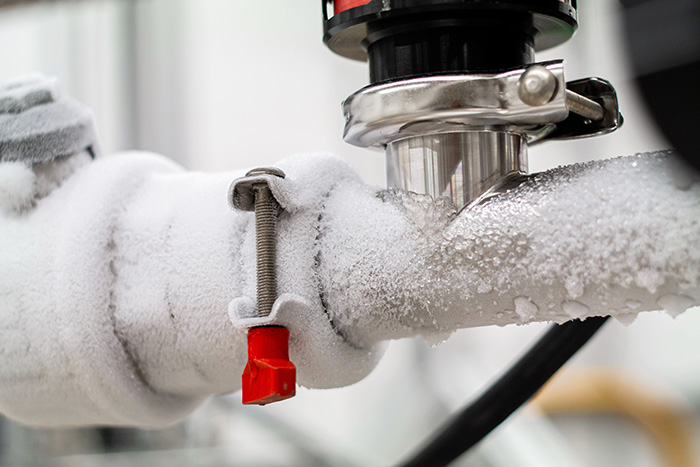Avoiding Frozen Pipes: Effective Tips for Winter
Avoiding Frozen Pipes: Effective Tips for Winter
Blog Article
This great article down below pertaining to Winter Plumbing Precautions: Preventing Frozen Pipes is immensely insightful. Give it a go and make your own assumptions.

Cold weather can wreak havoc on your plumbing, specifically by freezing pipes. Right here's just how to avoid it from happening and what to do if it does.
Intro
As temperature levels decrease, the threat of icy pipelines increases, possibly bring about expensive repairs and water damage. Understanding how to stop icy pipes is important for house owners in cool environments.
Prevention Tips
Protecting susceptible pipes
Cover pipelines in insulation sleeves or utilize heat tape to protect them from freezing temperature levels. Concentrate on pipes in unheated or exterior locations of the home.
Home heating methods
Maintain interior rooms appropriately heated up, specifically areas with pipes. Open cupboard doors to permit warm air to distribute around pipelines under sinks.
How to determine icy pipes
Try to find lowered water circulation from faucets, unusual smells or sounds from pipelines, and noticeable frost on exposed pipes.
Long-Term Solutions
Architectural changes
Take into consideration rerouting pipelines away from exterior wall surfaces or unheated areas. Add extra insulation to attic rooms, cellars, and crawl spaces.
Upgrading insulation
Buy high-grade insulation for pipes, attic rooms, and wall surfaces. Correct insulation aids keep consistent temperature levels and reduces the danger of icy pipelines.
Shielding Outdoor Pipes
Garden hoses and exterior taps
Disconnect and drain pipes yard tubes before winter season. Install frost-proof spigots or cover outside taps with shielded caps.
Understanding Frozen Pipelines
What causes pipes to ice up?
Pipelines freeze when subjected to temperatures below 32 ° F (0 ° C) for extended durations. As water inside the pipes ices up, it increases, taxing the pipe walls and potentially causing them to break.
Threats and damages
Frozen pipelines can bring about water interruptions, home damage, and pricey repairs. Ruptured pipelines can flooding homes and trigger substantial structural damage.
Signs of Frozen Pipeline
Recognizing icy pipes early can stop them from breaking.
What to Do If Your Pipes Freeze
Immediate activities to take
If you believe icy pipelines, maintain taps open up to alleviate pressure as the ice thaws. Make use of a hairdryer or towels taken in hot water to thaw pipelines slowly.
Conclusion
Stopping frozen pipelines requires positive procedures and quick responses. By recognizing the causes, signs, and safety nets, property owners can safeguard their pipes throughout cold weather.
5 Ways to Prevent Frozen Pipes
Drain Outdoor Faucets and Disconnect Hoses
First, close the shut-off valve that controls the flow of water in the pipe to your outdoor faucet. Then, head outside to disconnect and drain your hose and open the outdoor faucet to allow the water to completely drain out of the line. Turn off the faucet when done. Finally, head back to the shut-off valve and drain the remaining water inside the pipe into a bucket or container. Additionally, if you have a home irrigation system, you should consider hiring an expert to clear the system of water each year.
Insulate Pipes
One of the best and most cost-effective methods for preventing frozen water pipes is to wrap your pipes with insulation. This is especially important for areas in your home that aren’t exposed to heat, such as an attic. We suggest using foam sleeves, which can typically be found at your local hardware store.
Keep Heat Running at 65
Your pipes are located inside your walls, and the temperature there is much colder than the rest of the house. To prevent your pipes from freezing, The Insurance Information Institute suggests that you keep your home heated to at least 65 degrees, even when traveling. You may want to invest in smart devices that can keep an eye on the temperature in your home while you’re away.
Leave Water Dripping
Moving water — even a small trickle — can prevent ice from forming inside your pipes. When freezing temps are imminent, start a drip of water from all faucets that serve exposed pipes. Leaving a few faucets running will also help relieve pressure inside the pipes and help prevent a rupture if the water inside freezes.
Open Cupboard Doors
Warm your kitchen and bathroom pipes by opening cupboards and vanities. You should also leave your interior doors ajar to help warm air circulate evenly throughout your home.

We had been introduced to that editorial on How to Prevent Your Pipes From Freezing through an acquaintance on our other web blog. Feel free to take a moment to distribute this blog post if you enjoyed it. I praise you for being here. Revisit us soon.
Click Here To Read More Report this page